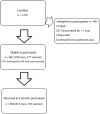Gender disparities in HIV treatment outcomes following release from jail: results from a multicenter study
- PMID: 24432878
- PMCID: PMC3953795
- DOI: 10.2105/AJPH.2013.301553
Gender disparities in HIV treatment outcomes following release from jail: results from a multicenter study
Abstract
Objectives: We assessed gender differences in longitudinal HIV treatment outcomes among HIV-infected jail detainees transitioning to the community.
Methods: Data were from the largest multisite prospective cohort study of HIV-infected released jail detainees (n = 1270)-the Enhancing Linkages to HIV Primary Care and Services in Jail Setting Initiative, January 2008 and March 2011, which had 10 sites in 9 states. We assessed baseline and 6-month HIV treatment outcomes, stratifying by gender.
Results: Of 867 evaluable participants, 277 (31.9%) were women. Compared with men, women were more likely to be younger, non-Hispanic White, married, homeless, and depressed, but were similar in recent alcohol and heroin use. By 6 months postrelease, women were significantly less likely than men to experience optimal HIV treatment outcomes, including (1) retention in care (50% vs 63%), (2) antiretroviral therapy prescription (39% vs 58%) or optimal antiretroviral therapy adherence (28% vs 44%), and (3) viral suppression (18% vs 30%). In multiple logistic regression models, women were half as likely as men to achieve viral suppression.
Conclusions: HIV-infected women transitioning from jail experience greater comorbidity and worse HIV treatment outcomes than men. Future interventions that transition people from jail to community-based HIV clinical care should be gender-specific.
Figures


Similar articles
-
HIV-infected men who have sex with men, before and after release from jail: the impact of age and race, results from a multi-site study.AIDS Care. 2016;28(1):22-31. doi: 10.1080/09540121.2015.1062464. Epub 2015 Aug 14. AIDS Care. 2016. PMID: 26275122 Free PMC article.
-
HIV-positive and in jail: race, risk factors, and prior access to care.AIDS Behav. 2013 Oct;17 Suppl 2:S108-17. doi: 10.1007/s10461-012-0340-9. AIDS Behav. 2013. PMID: 23086426
-
Contribution of substance use disorders on HIV treatment outcomes and antiretroviral medication adherence among HIV-infected persons entering jail.AIDS Behav. 2013 Oct;17 Suppl 2(0 2):S118-27. doi: 10.1007/s10461-013-0506-0. AIDS Behav. 2013. PMID: 23673792 Free PMC article.
-
Extended-Release Naltrexone Improves Viral Suppression Among Incarcerated Persons Living With HIV With Opioid Use Disorders Transitioning to the Community: Results of a Double-Blind, Placebo-Controlled Randomized Trial.J Acquir Immune Defic Syndr. 2018 May 1;78(1):43-53. doi: 10.1097/QAI.0000000000001634. J Acquir Immune Defic Syndr. 2018. PMID: 29373393 Free PMC article. Clinical Trial.
-
Methamphetamine use drives decreases in viral suppression for people living with HIV released from a large municipal jail: Results of the LINK LA clinical trial.Drug Alcohol Depend. 2019 Sep 1;202:178-184. doi: 10.1016/j.drugalcdep.2019.05.007. Epub 2019 Jul 16. Drug Alcohol Depend. 2019. PMID: 31352308 Free PMC article. Clinical Trial.
Cited by
-
The Association Between HIV Disclosure Status and Perceived Barriers to Care Faced by Women Living with HIV in Latin America, China, Central/Eastern Europe, and Western Europe/Canada.AIDS Patient Care STDS. 2016 Sep;30(9):435-44. doi: 10.1089/apc.2016.0049. Epub 2016 Aug 23. AIDS Patient Care STDS. 2016. PMID: 27551959 Free PMC article.
-
Longitudinal Viral Suppression Among a Cohort of Adolescents and Young Adults with Behaviorally Acquired Human Immunodeficiency Virus.AIDS Patient Care STDS. 2017 Sep;31(9):377-383. doi: 10.1089/apc.2017.0078. AIDS Patient Care STDS. 2017. PMID: 28891717 Free PMC article.
-
Housing Status, Medical Care, and Health Outcomes Among People Living With HIV/AIDS: A Systematic Review.Am J Public Health. 2016 Jan;106(1):e1-e23. doi: 10.2105/AJPH.2015.302905. Epub 2015 Nov 12. Am J Public Health. 2016. PMID: 26562123 Free PMC article.
-
HIV-infected men who have sex with men, before and after release from jail: the impact of age and race, results from a multi-site study.AIDS Care. 2016;28(1):22-31. doi: 10.1080/09540121.2015.1062464. Epub 2015 Aug 14. AIDS Care. 2016. PMID: 26275122 Free PMC article.
-
Care Navigation Increases Initiation of Hepatitis C Treatment After Release From Prison in a Prospective Randomized Controlled Trial: The C-LINK Study.Open Forum Infect Dis. 2022 Jul 28;9(8):ofac350. doi: 10.1093/ofid/ofac350. eCollection 2022 Aug. Open Forum Infect Dis. 2022. PMID: 35949401 Free PMC article.
References
-
- Benbow N, Scheer S, Wohl A . Linkage, retention, ART use and viral suppression in four large cities in the United States. Oral poster presented at: XIX International AIDS Conference; July 23, 2012; Washington, DC.
-
- Hall HI, Gray KM, Tang T, Li J, Shouse L, Mermin J. Retention in care of adults and adolescents living with HIV in 13 U.S. areas. J Acquir Immune Defic Syndr. 2012;60(1):77–82. - PubMed
-
- Springer SA, Pesanti E, Hodges J, Macura T, Doros G, Altice FL. Effectiveness of antiretroviral therapy among HIV-infected prisoners: reincarceration and the lack of sustained benefit after release to the community. Clin Infect Dis. 2004;38(12):1754–1760. - PubMed
Publication types
MeSH terms
Substances
Grants and funding
LinkOut - more resources
Full Text Sources
Other Literature Sources
Medical

